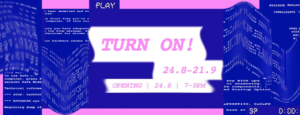‘The past is not “memory” but the archive itself, something that is factually
present in reality,’
-Boris Groys



Subversiv
Mixed media installation
Monitor, Schedule book, HGB record
2018
I contemplate about what HGB is for me, what is inside the
archive of HGB. Then, I found a record, ‘Bericht der königlichen Akademie für
graphische künste und Buchgewerbe zu Leipzig 1912 bis 1914’, which is about
is out of our control in some ways. There are no script and no rehearsal for this
video. The record, which represents the history of HGB, is put next to the
security camera monitor to demonstrate the past and present. The monitor
shows the daily activity of a student’s apartment, which is happening ‘now’. The
past and present, the great university and the little student form a strong
contrast. The security camera is facing upward from the ground as to give a
unclear view of the environment and create a feeling of being peeped, or an
invasion of privacy, which normal position of security camera is placed from the
ceiling and facing downward in order to give a whole view of the space.
Moreover, the security camera is monitoring the main entrance of the apartment,
filming the in and out activities of the apartment, which responds to the official
HGB record of professors’ holiday. The live video describes different the
perspectives towards HGB from a student and from the authority. I have also
recorded the number of in and out activities of the main door, kitchen and
bathroom in order to respond to the HGB record.
On the other hand, the HGB record also includes the amount of
teaching material used from 1912-13. For example, 577 books and works and
496 single sheets are used. The books compose 59 art history, aesthetic, critic
books, 69 world and cultural history books…etc. The use of single sheets includes
64 sheets for etching, 22 sheets for woodcarving, 20 sheets for lithography…etc.
This detailed information is very rare nowadays and would not be able to find
it on HGB website. We have rich resources and technology nowadays and there is
no more need to control the usage of single sheets. I found these numbers are
very interesting and would like to further develop the concept by collecting the
number of books and paper usage in my daily life. Therefore, I started to record
how many book I read, how many paper I used and the purpose of use as a part
of the installation for this An_archive project in order to respond to the strict and
detailed HGB record. As I rarely use paper for artistic purpose currently, I also
counted the tissue paper usage everyday. The collected number will be a living
archive. Archive exists everyday. As Diana Franssen proposed, ‘looking at your
own archive through the lens of another archive [that] you are able to learn […]
about your different positions’.8 During the recording of number of tissue paper
usage in my daily life, I found that it is difficult to maintain the accuracy.
Sometimes I forgot to record after I consumed a few toilet papers. The HGB
record amazes me again with its accuracy and strictness. When I am recording
the numbers, I am actually making choices. Deciding what to be recorded or
deleted to build a personal archive.


Detail of HGB record, Photo by Chang an
 mare nostrum
mare nostrum






































